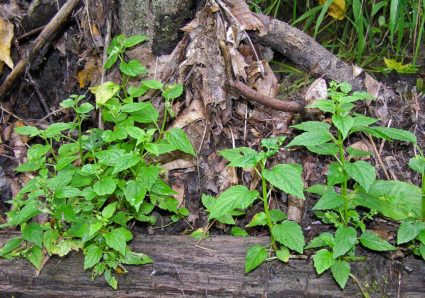
Skullcap is a favorite plant among many favorite plants. It is a plant I have spent a lot of time around, which will add to the length and depth of this monograph. I hope that this writing helps people appreciate skullcap both as a medicine and also as a creek bed denizen.
My Story
I have been intrigued by skullcap for many years, since my early days studying herbal medicine. This is partially because it is so well-spoken of in the medicinal herb world, plus it is a plant I can find on my own and watch grow through the seasons. While it is not a particularly showy plant, it has a striking dark green color, nice veins, and grows in the kind of streamy lowland woodlands that I like to naturalist my way around in.
A story. I used to live in an un-electrified cabin in a community in the woods outside of my adopted hometown of Ithaca, NY. One afternoon after waking from one of my regular daily naps, I had a strong notion where I might find this plant, which I hadn’t seen around often. So groggily I walked the quarter mile or so to a place I have walked frequently and there it was, growing along a streamlet. Well, that surprised me. But once I realized its preferred habitat, I was able to find it in a number of places around my home. Which was my beginning of getting a first-hand view of this plant.
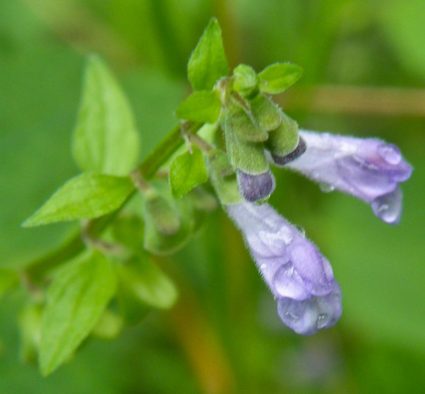
Skullcap Botany
Skullcap is the common name (often modified with a preliminary word, such as mad-dog skullcap) of the genus Scutellaria. Both the common name and the genus allude to a sticking-up part on top of the plant’s calyx. Scute means ‘little dish’ and you will have to use your imagination for this allusion. But the important thing is when trying to determine if it is a Scutellaria, is to look for this protuberance on top of the calyx, a good indicator to the genus as this feature is only found on Scutellaria (the plant must be in at least in the early flowering stage to see this).
The genus Scutellaria is in the mint family-the Lamiaceae (also known as the Labiatae). While many mint family relatives are noticeably aromatic, Scutellaria is not. This family contains a number of other useful nervines including, Motherwort (Leonurus), Lemon balm (Melissa), and Tulsi (Ocimum).
There are many species of Scutellaria around the US and Canada. Most of my writing here is refers to Scutellaria lateriflora, because it is the one that I have used the most, as it is the most common around where I live. It is also the one most cited in North American herbal literature.
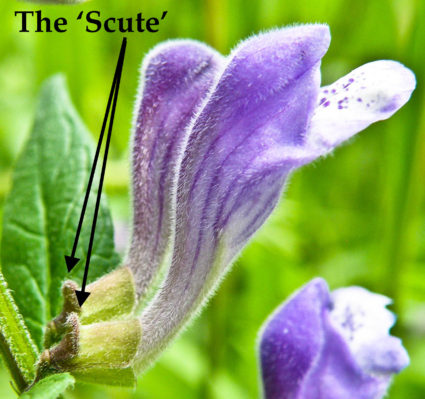
But other species are often used as well. The herbalist Joshua Muscat in Oakland uses a west coast species Scutellaria antirrhinoides, and Kiva Rose, an herbalist in the Gila region of New Mexico uses her local species, Scutellaria potosina which she calls blisswort.
A species I would like to try more often is Scutellaria galericulata, as I see this one with some frequency. Like S. lateriflora, it also inhabits wet places.
The point here is that many Scutellaria species are used as medicine. So learn your local species, look and ask around to see if you can find any resources about it, and please make sure it is not threatened or poisonous before using it.
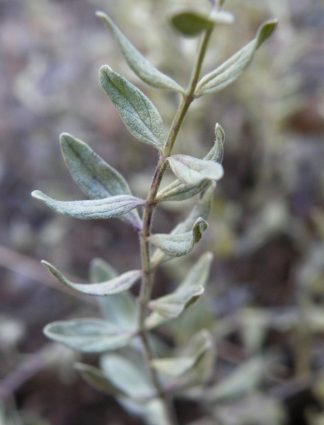
Medicinal uses
So why all the fuss about skullcap? Here is a list a few of its uses which will be covered in a little more detail further on.
- A generalist herb useful for a number of nervous system related problems
- Nerve tonic (also known as a neurotrophorestorative), mainly for Pitta types.
- Pain remedy
- Both skeletal and smooth muscle relaxant
- A relaxing sedative generally without the knock-you-out effect, making it useful for daytime use
- Works well in formula with other nervines and relaxants.
- Can be used for acute conditions or as a tonic for long-term problems
- Gateway herb, to help get people interested in herbal medicine due to its effectiveness.
To start with the obvious and necessary, while Scutellaria can help with the above conditions, it may not, as individual constitution dictates. While I have seen it help many people over the years, ironically it does very little for me. I have taken large (and by large, I mean swallows) of the tincture. And for an experiment during one of my gathering trips, I ate about 10 plants worth. And, well, very little action. But as any clinician knows, you cannot use yourself as the standard barometer for treatment.
I generally use this plant in two forms; fresh plant tincture and dried plant tea. I use the tincture for all the below situations and tea mainly for its nervine effect, (usually mixed with other herbs).
Pain
Skullcap is a useful general pain remedy, helpful for a wide range of problems such headaches, injuries, spasmodic pains such as cramps and general body pains.
It is not the strongest pain remedy I know, but it has some particularly useful traits. It can help focus and amplify the efficiency of other remedies. For instance, if you are giving crampbark (Viburnum opulus) for menses pain, by adding some skullcap to the mix as it can augment the crampbark to help with the cramping. Other examples include using it with feverfew (Tanacetum parthenium) for headaches, or Pedicularis for back pain.
Another helpful characteristic is that Scutellaria is less likely to cause lethargy or mind fog then plants like valerian (Valeriana spp.) or hops (Humulus lupulus). This is important as a pain medicine and for its use as a nervine, as people can take it while performing tasks that they need to be cognizant for.
Dosage for pain. Remember individuality here, especially with nervous system remedies. Start small, you can always initially try just a few drops to check for reactions. You can then have the patient take measured amounts, continually increasing them incrementally in ½ dropper doses, until they find the relief they seek, or realize that Scutellaria is not helping and to try a different medicine. The general rule when administering any herbal medicine is to consider the amount and the frequency. For background chronic pain between ½-2 dropperfuls (.60-2.5 ml) as often as every 2 hours. For acute pain, there really is no limit except for the person possibly feeling out of it eventually. It is a useful first aid remedy and for those doing first aid work it is helpful to have a large bottle on hand.
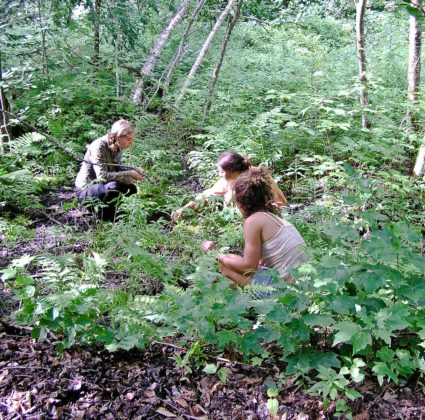
Nervine
Besides its use for acute and chronic pain, skullcap is helpful as a constitutional tonic. Before I go into specifics, please consider experimenting with this plant even if the situation doesn’t fit the below guidelines. In terms of Ayurveda, it is most helpful for Pitta types. I see it most useful for people who constantly need to take charge. They make constant contingency plans and feel personally insulted when things don’t go their way. They may have insomnia and cannot initially fall asleep due to thinking about all the things they could have done differently that day. They might worry about their performance about everything (‘was the dinner okay?’) and are expert at criticizing themselves, and others.
One other place I find skullcap helpful, is for people who have an emotional attachment to their injury. This is common. When the person thinks about how they sprained their ankle or got stung, there is an upsetting emotional quality to it. With this type of person you may see them blaming themselves for the injury (‘I knew I shouldn’t have run that trail’) Skullcap may help relieve the physical pain and some of the emotional pressure.
Consider using some other nervine tonics in conjunction with skullcap such as passionflower (Passiflora incarnata), Jamaican dogwood (Piscidia piscipula), blue vervain (Verbena hastata) and catnip (Nepeta cataria).
Skullcap can be given at least a few ways for the above implications. With tincture, regular tonic doses somewhere between ½-2 dropperfuls (.60-2.5 ml) 2-5 times daily, or for more acute situations anywhere from a ½ dropperful to a teaspoon. For tea, a good strong cup (.40 oz to 1 quart water) drank a few times a day in half cupfuls. Experiment.

Medicine making and Preparations
With Scutellaria I gather aboveground parts including the stems, leaves, while the plant is in flower for medicine. I mainly prepare it as fresh plant tincture, 1:2 in 95% alcohol soon after gathering it. I comb through the plants and pick off sick looking leaves, and then chop it all up with a cleaver. It is a soft plant and easy to process.
It is also a useful tea, but I rarely gather enough to dry any. It is very light, and so you have to have a lot, to get just a pound of tea. But I sometimes receive donations for the Ithaca Free Clinic, and I use it often there in this form.
Wildcrafting
This section is going to be about Scutellaria lateriflora as I gather this plant nearly yearly from the same spot and have been taking many notes along the way. You may have to indulge my rather long wildcrafting chapter here.
First, this is a plant that one must be careful about harvesting, as while it is not uncommon in its favored habitats, it is rarely prolific. So please walk and wildcraft gently where you do find it. Make sure after gathering that you can look back and still see a healthy population in a not very disturbed ecosystem. I should say that I have told only 1 or 2 people about the spot I go to. It may be selfish of me, but I feel like this large area I gather from can only sustain one wildcrafter. I go there to harvest by myself and have not yet seen another person, which allows me to be more present with the plant, the environment, and myself. Whenever gathering any plants, do not gather from the first patch you find it in, as it might be the only one around. Give yourself time to wander and make sure there is enough that you can harvest some and there is plenty left to reseed itself as this Scutellaria is an annual.
I generally gather the upper 2/3’s of the plant, making sure some of them have seeds left on them. They have a delicate root system, so be careful to not pick them out of the soil thus not give the plant time to mature its seeds.
I gather two ways, sometimes I use my pruners and other times I pinch the stems off with my fingers. Both ways work well, I just alternating my patterns.
Around Upstate New York, the best time to gather is while the plant is in full flower, sometime between mid-August and early September. This skullcap likes it shady and wet. I find it most often along small creeks in woodlands. There are some mosquitoes this time of year, so bring a long-sleeve shirt and hat and I’d recommend wearing a good pair of sandals and some pants you can roll up, as you will probably be doing a fair bit of stream walking. It takes a little while to learn to sort Scutellaria out from amidst the other vegetation, but once you do, it becomes much easier to see. One of its most distinctive features is the dark green color. Some of its common plant associates include
- Jewelweed (Impatiens capensis)
- Goldenrod (Solidago species)
- Early flowering Asters (different genera)
- Raspberry (Rubus idaeus)
- Witch hazel (Hamamelis virginiana)
- Hemp nettle (Galeopsis tetrahit)
- Turtlehead (Chelone glabra)
- Sensitive fern (Onoclea sensibilis)
- Bracken fern (Pteridium aquilinum)
- Avens (Geum species)
A few more wildcrafting notes. It is easy to get lost gathering Scutellaria as you will be meandering and following an unorganized path through the rivulets. Make sure to take stock of where you are every once in a while. As it can take a few hours to gather enough I suggest bringing snacks and water with you. I use large brown paper bags as I can fold the tops back so I can put the bag down and it will stand on its own while I am gathering. Double bagging is helpful, as the ground will be wet and the bag may rip. Bring a few extra.

Final Notes
As should be obvious by now I admire Scutellaria lateriflora. I enjoy finding it on creek bottoms, spending time gathering it for medicine and observing the other life around where it grows. I also like it as a broad-ranging nervous system remedy and a fairly safe herbal remedy for a wide variety of people and problems. I hope this monograph enhances your appreciation of this plant as well, and that you use this and other species of Scutellaria in your herbal practices.

Very nice:) Thank you for sharing 7song:)~
Thank you Lina
Very informative. I didn’t know about it’s ability to strengthen other herbs in formula. I’m excited to try it in this way. I love using it with milky oat pods as a nervous system trophorestorative that is helpful for most people. Thank you for sharing your knowledge!
One of my favorites. Just purchased some seed this year and am going to try to cultivate. We do have a native skullcap up here in the Ozarks. Will have to do some research to find out which one it is. Thanks for sharing your knowledge.
I have had scullcap in my “medicine cabinet” for some time now as I knew it was a good nervine. I did not know it was highly recommend for the Pitta personalities and fine for day time consumption. I will be increasing my intake of this plant and think of the quiet peaceful streams it meanders and grows by perhaps getting one step closer to my personal calm!!! Thank you 7song for sharing your appreciation and experience with this plant. That’s funny how you ate many plants w/little affect. That made me chuckle and smile!
I used to take skullcap from my Mom, who would give it to me if I couldn’t sleep or felt especially nervous. I had always liked it but was unable to find it in Canada these days until recently it showed up again.
Last night, my husband tried some to help him sleep. He takes a sleeping pill regularly (Zoplicone) because of his rotating shifts. He also takes a mild anti-depressant (Venaflaxine.). I was just wondering if you could tell me if you think it’s safe to take with an anti-depressant or not, and if it’s safe for daily use. I love this herb but I want to be careful with my husband.
Thank you so much!
Will put a link on your Facebook account in Poland and I strongly commend to your blog: The Skullcaps-A Scutellaria Monograph Blog – Northeast School of Botanical Medicine. And I have many friends who are interested in medicine, I’m a doctor. I cordially greet and welcome to the blog in our country.
This is my favorite personal plant besides violet. I am a thin vatta, not pitta, and it is so incredibly helpful to me but I never need more than 10 drops. I tincture or tea. It gives me the effect of having meditated, and when first learning to meditate, it helped me to learn to sit long enough. It is a lovely plant, with delicate blossoms, highly reactive, it will wilt when injured, and yet its root system is incredibly strong in contrast. much like myself. for those of us lacking earth groundedness, perhaps too much in the head or worrisome, it is a great ally.
Thank you so much for sharing this!! Skullcap was the first plant I ever walked with and it changed my life. I love it as a nervine.
Thank you for this Tabitha.
~7Song
Hi, just wondering if there is any relation to the chinese herb huang qin that, i thought, was scutellaria? There doesn’t seem to be too much overlap in terms of use- (though i think that huang qin is the root).
Thanks 7song, VERY helpful!
Gratitude.
Hello from Israel. We have 4 species of Scutellaria here. S. galericulata is listed but has not been seen since 1941, and two are rather rare, beautiful mountain flowers that cannot possibly be collected ethically, the more so since harvesting herbs in the wild is generally frowned upon in this arid country, when it’s not outright illegal.
The only common species is Scutellaria brevibracteata, formerly S. subvelutina, and while it is nowhere abundant, you can reasonably expect to encounter it while trekking in our Mediterranean forests, especially in the Northern part of the country.
I have searched the web, and talked about this with knowledgeable people, but nobody seems to know anything about this plant’s medicinal properties. The best piece of advice I got was to ask Druze elders about this, but the Upper Galilee is a bit far away and in any case well outside my non-motorized roaming range.
There is a possibility that this species has been overlooked by folk medicine due to its relative scarcity. Other local Lamiaceae which had never been used by the local herbalists have been proven to contain interesting, and potentially profitable molecules once researchers had the opportunity, the curiosity and the funds to take a look at them. The other possibility is, of course, that Scutellaria brevibracteata is entirely worthless in the pharmaceutical sense.
You have mentioned that American herbalists have been known to use Skullcap species other than the ones known as medicinal. I want to try this one, and I’d be delighted if you could provide me with a methodology to do so, using myself only as a guinea-pig since I do not have access to a lab at the moment.
It goes without saying that I am not going to collect any material in the wild, but that I shall instead establish small colonies of this plant in community gardens, from seeds provided by the local university botanical garden.
Please kindly e-mail me if you can be of help.
Thanks 7Song, I appreciate this online information, I am going thru Chinese Medicine School and am worn out from studies, and kinda tired of herbs from half way around the world. Looking for western herbs to lend some support. Thanks Again.
Hi, thank you for all the info. I saw that this plant was used in LT03, which is a supplement for hyperactive kid with Attention deficit. I am already giving Omega-3 to my 7yr old son, and was wondering how I could use Scullcap for him and what would be the dosage.
Thank you!
This is an excellent informative write-up that was a genuine pleasure to read. After years of looking, I think I may have stumbled on some Scutellaria Galericulata literally in my own back yard this afternoon! I have been on a quest to compile enough research to make a positive ID ever since I picked a small sample. Happy wildcrafting!
skullcap has ability to strengthen other herbs in a formula ??